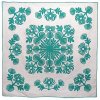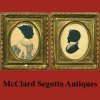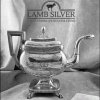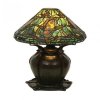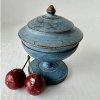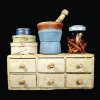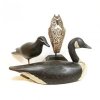"Tradition of Progress" Exhibit
February 7th, 2015
|
A section of balcony railing made by the Rose Iron Works, Cleveland, circa 1927, serves as a focal point at the entrance of A Tradition of Progress. Overhead is one of four name boards from the steamer Queen City. Made of painted wood, it dates to 1897.
Cambridge Glass Company items shown at A Tradition of Progress include this ball pitcher and eight matching tumblers. In the #3400 line and with applied silver decoration at the edges of the flowers and some leaves, this set dates to the 1930s or 1940s.
Second Empire architecture is mimicked in the design of this parlor stove, made circa 1875 by the Perry Stove Company, Salem, Ohio. Fancy stoves such as this were often placed in rooms where guests were entertained.
Among the decorated stoneware in the exhibition is this imposing water cooler from Akron, Ohio. Note the jug-shaped motif around the bung hole. The piece is dated 1876.
Shop of the Crafters operated in Cincinnati from 1904 to 1919. Circa 1910, this is one of two matching side chairs in oak with inlay designed by Paul Horti.
Henry L. Fry was an instrumental figure in the art-carved movement in Cincinnati. This mantel was made for Sunflower Cottage, a Gothic Revival house built by Fry and his second wife. Decorative elements include sunflowers and lilies. The floral-motif andirons in wrought iron and bronze were designed by Paul Feher for Rose Iron Works, Cleveland. On the mantel is a silver-plated salver produced by Homan Manufacturing Company, Cincinnati.
Arts and Crafts furniture and accessories are the focus in this gallery, with items ranging from furniture to pottery.
The smaller size of the KitchenAid model G stand mixer significantly increased sales over the previous version. Made from 1928 to 1931 in Springfield, Ohio, the steel and chrome appliance was proof that good design could help sell common household items.
Made around 1890 to 1910, this roll-top desk by Conant Brothers Furniture Company, Toledo, is typical of large pieces of furniture from the Victorian era. The fitted interior was designed to maximize the efficiency of the user.
Both paint-decorated and stenciled, the blanket chest in the foreground was made by Jacob Werrey of Fulton County, Ohio. Little is known about the Mennonite craftsman. |
At the top of a curving staircase in the Reese-Peters House, home to the Decorative Arts Center of Ohio, visitors since February 7 have been greeted by a section of wrought-iron balcony railing, an arched name board from an Ohio River steamboat, and a crisp-looking panel announcing the exhibition housed through doors to the left and right. In Art Deco-style type it reads, “A Tradition of Progress: Ohio Decorative Arts 1860-1945.”
Part metaphor, part metamorphosis, A Tradition of Progress offers an intriguing view of cultural heritage in the Buckeye State. Open in Lancaster through May 17, the exhibition is the sequel to Equal in Goodness: Ohio Decorative Arts 1788-1860, which was featured at the same location in 2011.
Andrew Richmond, vice president of Garth’s and a M.A.D. columnist, returns as curator for this second show, which in the planning stages had the working title of Equal the Sequel. However, A Tradition of Progress found its own identity and gained its own voice. In the process, it did something else. It accomplished the nearly impossible by summing up 85 years of decorative arts in 152 individual objects and groupings.
The items showcased were made in Ohio during a period that began before the Civil War and ended after the conclusion of World War II. It was a time when America had become fully industrialized, transitioning from handwork to machine-made goods. And it was an era when middle-class Americans had enough change jingling in their pockets to splurge on objects that were not merely functional but were also decorative. These everyday folks were no Rockefellers, but they could begin to furnish their homes with nice items that bespoke of the upward mobility of the U.S. populace.
That’s where part of the metaphor comes in, as the material found in A Tradition of Progress represents more than just a period of time, but also the American dream of living a life bigger and better than one’s ancestors. The metamorphosis can be seen in the five rooms where the exhibition is presented, as visitors advance counterclockwise, essentially turning back time. Distinct periods within the framework of the exhibition get their own space.
The show picks up where Equal in Goodness left off, in the middle of the 19th century, when individuality and quality workmanship were expressed through objects such as an ink and watercolor family register from Allen County, a fraktur depicting birds, roses, and tulips, and with dates ranging from 1848 to 1889; a large double-handled salt-glazed water cooler with a cobalt decoration of a bird on a branch, lettered “Harley & Carll/ Ohio Stoneware/Akron O” and dated 1876; and an 1885 paint-decorated blanket chest by Jacob Werrey of Fulton County.
Through the next doorway, one steps into the Gilded Age, represented by a pair of ceramic potpourri jars made by the Homer Laughlin China Company of East Liverpool, urn-shaped vessels having white-on-blue ovals depicting Classical figures, reminiscent of Wedgwood’s cameo wares. In contrast, a cast-iron parlor stove made by Perry Stove Company of Salem exemplifies how even the most utilitarian of items were sometimes crafted with a flair, as the stove takes the form of a Second Empire-style house.
The next doorway moves visitors to the late 19th century, with the large, clunky furniture of the Victorian era offset by the bright, strong graphics of the period, the latter represented by a number of items related to Ohio’s centennial celebration in 1888, including colorful broadsides printed by the Krebs Lithographing Company of Cincinnati, as well as trade cards given away by merchants in hopes of promoting business. These include one for the Cleveland Dryer Company of Cleveland, which illustrated the transition from log cabins to modern farms, all the while promoting bone phosphate fertilizer.
Another doorway, another era, as the Arts and Crafts movement is explored, with Cincinnati art-carved furniture highlighted by a fireplace mantel carved by Henry Fry and a writing desk carved by his son, William Fry. The sunflower motif of the mantel is seen again on a glazed architectural tile by Mary Louise McLaughlin of Cincinnati, one of a variety of pieces of art pottery from makers that include Ohio’s big three: Rookwood, Roseville, and Weller. Arts and Crafts furniture includes a pair of tall-back side chairs by the Shop of the Crafters of Cincinnati, while metalwork is represented by a brass, copper, and enamel sconce by Horace E. Potter of Cleveland and a silver and ivory letter opener by Potter Studio, also of Cleveland.
The final room takes visitors toward the modern era, highlighted by a variety of Art Deco pieces, including a Jazz bowl designed by Viktor Schreckengost and made by Cowan Pottery of Rocky River; a circa 1933 quilt in blue, gray, and white, showing skyscrapers, dirigibles, and airplanes, crafted in Akron; and even the most mundane of household artifacts, a Hoover vacuum sweeper and a Kitchen-Aid stand mixer.
At times the same company is represented from room to room, showing the variety of its output. That’s most apparent with Rose Iron Works, founded in 1904 and still in business in Cleveland. The wrought-iron railing that greets visitors at the entrance to the exhibit is Rose Iron. A presentation drawing for a Rose Iron chandelier hangs among the Gilded Age material. A pair of floral-motif andirons from Rose Iron, accompanied by a related design drawing, appears with the Arts and Crafts goods. The room highlighting Art Deco contains a pair of cactus-motif andirons and a concept drawing, as well as a table lamp.
Putting it all together was no easy chore.
Richmond noted that A Tradition of Progress was harder to pull off than Equal in Goodness. “In part, because I moved well into territory about which I had little knowledge,” he said. “By the time I began work on Equal, it was well-trodden terrain for me. But for Tradition, I had so much to learn. I was comfortable with my knowledge of Ohio history and culture during that time period, and I certainly was familiar with many of the makers (Mitchell and Rammelsberg, Heisey, Cowan, et cetera), but it’s such a complex story. Such a big story. And the sheer volume of material that is available to cover this time period is utterly staggering. Think about how much Ohio art pottery you’ve seen in the past few years—any or all of it would have helped tell my story,” he said.
“For Equal, for some parts of the story, there was only one, or perhaps a few objects that could have sufficed. Here, there were often hundreds.”
A Tradition of Progress posed the challenge of “simply telling this big and complex story that involves so many people and companies with only 150 objects,” added Richmond. Covering some aspects of that story in little time and limited space was also a test. It wasn’t just a matter of what to add, but sometimes what to leave out. The numerous makes of Ohio art pottery and glassware could fill a museum until the contents spilled out the doors and fell from the windows.
Richmond relied on others for help. “There are so many folks out there who know Rookwood, Roseville, Cambridge Glass, et cetera, far, far better than I. To tell their part of the story in a way that I felt good about, and in a way that I thought the real experts would be pleased with, that was not easy. I relied heavily on the hard work of so many of those experts, either their writings or through talking with them. I hope I did OK.”
From an initial list of about 225 objects, Richmond trimmed his final selection by a third. “Much of what I cut were other examples by makers already covered (but that illustrated the breadth or depth of their production), and certainly a few lesser-known makers that I had to sacrifice. It was a painful process, to be sure. And even still, the galleries feel fuller than they did with Equal. But that’s OK with me. Others might have tried to tell this story with only eighty ‘great’ objects, but I feel very strongly that talking about our past through objects is not just about highlighting the ‘best.’”
In the end, he accomplished what he started out to do, and visitors might find the results somewhat surprising.
“A big part of the story of Tradition is the birth of the American middle class, and as such, I needed to include some ‘common’ objects. And doing what I do for a living, I like this as well because that means that I can point to objects that are readily available in the market, and even inexpensive. I wanted to engage with as broad a cross-section of visitors as I could, and so selecting a group of objects that are diverse in a number of ways was how I chose to accomplish that,” he added.
“Ultimately, as I said, it’s a big story, a complex story, and a fascinating story. Innovation, mechanization, the evolution of production from maker-driven to designer-driven. In truth, I barely scratched the surface. But I hope I am able to connect with visitors. And I hope I’m able to turn a few heads with some unexpected choices (say, a vacuum). If you can’t find something you like in A Tradition of Progress, then you simply aren’t paying attention.”
 Richmond said a third installment in the series should happen, likely presenting Ohio decorative arts from 1945 to the present, but he noted “that’ll be a project for someone else who has more expertise with modern and contemporary works.”
Richmond said a third installment in the series should happen, likely presenting Ohio decorative arts from 1945 to the present, but he noted “that’ll be a project for someone else who has more expertise with modern and contemporary works.”
An accompanying catalog for A Tradition of Progress is available from the gift shop at the Decorative Arts Center of Ohio. For more information, phone (740) 681-1423 or visit (www.decartsohio.org).
Originally published in the May 2015 issue of Maine Antique Digest. © 2015 Maine Antique Digest





